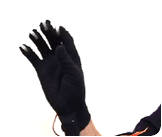Interactive artists and musicians have long experimented with sensor-packed gloves for controlling music, sound, and video. There’s Laetitia Sonami, who controls Max/MSP with her Lady’s Glove, and many other projects like the Hypersense Complex flex sensor glove-cum-gestural software as seen here this summer. Laetitia’s glove is elegantly sculptural, as seen below, and with years of practice performing with it, she’s built a whole performance practice around the glove as an instrument.

 Eric Singer deserves special credit in this category. (See link for projects and videos.) In the early 90s, he hacked the Mattel PowerGlove, a controller for the Nintendo NES, for music. He followed that in 1999 with a Wireless MIDI Glove (right), which sends pressure and bend data for each fingertip.
Eric Singer deserves special credit in this category. (See link for projects and videos.) In the early 90s, he hacked the Mattel PowerGlove, a controller for the Nintendo NES, for music. He followed that in 1999 with a Wireless MIDI Glove (right), which sends pressure and bend data for each fingertip.
So, what’s next?
Music thing gets the scoop on the latest iteration of the “gloves for music” trend, with a wireless model developed by 24 year-old Computer-Engineering grad Shaduz of Bologna, Italy:

3DID (3D Interaction Device) Project Page (Basic specs, photo, video)
You can tell the 3DID is a 2005 project: it’s got all the sexy modern specs you could want. Wireless is available via Bluetooth, with wired USB, serial, and Ethernet options. Data is transmitted as “oldskool MIDI,” yes, but also via OpenSoundControl (OSC), and there’s a TCP/IP driver, as well. Unlike Eric’s wireless glove, Shaduz doesn’t just rely on bend data: he adds 3 gyroscopes and 3 accelerometers, so the position of your hand can be expressive, as well. (That’s similar in conception, in fact, to the 3D controller Nintendo is working on for its upcoming Revolution console.) It’s all very cool, but I can’t help but wonder if it’s a little too complicated: sometimes focusing on fewer controls (as with Eric’s wireless glove) can be more expressive. But the really good news here is that all these features are possible with low power consumption, low weight, and EUR150 in parts.
Of course, the next step is taking time to learn the controller as an instrument. Imagine you’ve just invented the piano: you’d better take another few years and actually learn to play it.
If you want a wireless glove without doing all this work (albeit a simpler one), check out the very inexpensive P5 data glove: see CDM’s brief how-to, free Windows software. (The glove itself can be used on the Mac, too, with a little effort.)
Will interactive gloves ever make an impact as an expressive control for computers? The technology is here; my guess is it now depends on whether artful musicians can make that technology expressive, not the other way around.